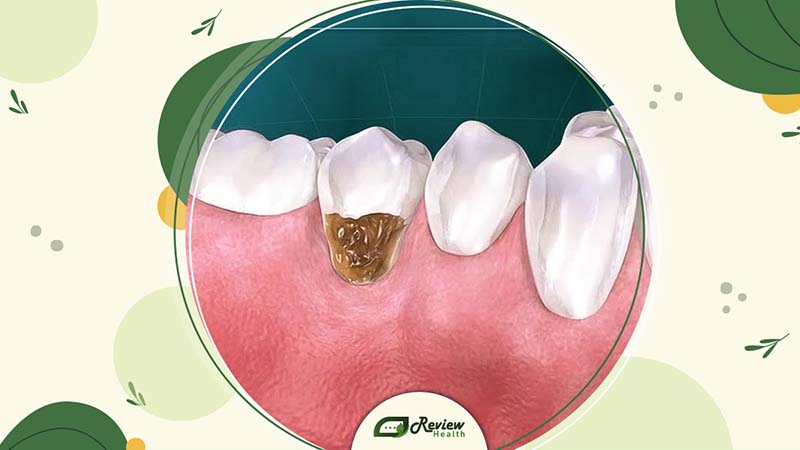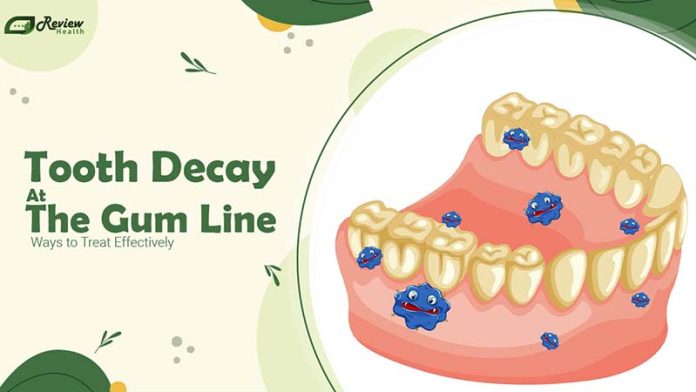Tooth decay at the gum line presents a unique dental challenge, often occurring where the tooth meets the gums. This type of decay is commonly associated with exposed tooth roots due to gum recession, which can stem from gum disease. The exposure of these roots leaves them particularly susceptible to decay and can lead to significant discomfort. To understand more about this condition and explore effective prevention and treatment strategies, consider reading informative articles on Review Health. This resource offers valuable insights into maintaining optimal oral health and addressing issues like gum line decay before they escalate.
Tooth Decay at Gum Line: What Is the Cause?
The primary factor contributing to tooth decay at the gum line is dental plaque. Plaque forms a sticky film on the teeth when bacteria in the mouth break down sugars from foods and beverages. These bacteria then produce acids as a by-product, which can erode the hard enamel surface of the teeth. If not regularly removed, plaque can harden into tartar, a yellowish deposit that builds up along the gum line and on the teeth.

Additionally, as people age, their gums naturally recede, exposing the softer root surfaces that are covered by cementum. This cementum is less resilient than the tough enamel that protects the rest of the tooth. As a result, these exposed areas are more vulnerable to plaque accumulation and subsequent decay, significantly contributing to the formation of cavities along the gum line.
How to Treat Black Tooth Decay at the Gum Line
Cavities at the gum line can lead to serious complications such as gum and tooth abscesses if not treated promptly by a dental professional. However, there are preventive measures that individuals can take to minimize the risk of such cavities:
- Routine Oral Care: It’s essential to brush twice daily and floss daily to remove plaque and prevent tartar build-up. Biannual dental check-ups are crucial for maintaining overall oral health. When brushing, it’s important to use gentle strokes to avoid damaging the softer cementum on the root surfaces, which can lead to increased sensitivity.
- Early Detection and Remineralization: In early stages of gum line decay, where there’s minor demineralization affecting tooth coloration, dentists can often stop the decay. This treatment might involve managing any underlying gum disease, cleaning plaque and tartar, and applying fluoride to remineralize the affected areas. Unfortunately, decay at the gum line can often progress without noticeable symptoms until a cavity forms.
Moreover, depending on the severity and location of the decay, different treatments may be required:
- Filling Cavities Above the Gum Line: Similar to conventional cavities, those above the gum line can be treated by removing decayed material and filling the cavity. This helps prevent further decay. For aesthetic purposes, many patients choose composite fillings that match the color of their natural teeth.
- Addressing Decay Below the Gum Line: Decay that extends below the gum line is more complex and might require a root canal. This procedure involves cleaning the root of the tooth, removing infected tissue, and sealing it to prevent further infection. For teeth in the back of the mouth, a crown might be recommended post-treatment to provide additional strength and protection.
- Surgical Intervention: In severe cases, a minor surgical procedure may be necessary to cut into the gums to directly access and clean the decayed area before sealing it back.
Seeking timely dental care is crucial for effectively managing decay at the gum line and preventing more severe oral health issues. Regular check-ups allow for early detection and management of potential problems, ensuring healthier teeth and gums.
See more articles:
- Understanding Wisdom Tooth Decay: Symptoms, Causes, Signs identify and Pain-Free Treatment Options
- What Does Tooth Decay Smell Like and How Can We Effectively Eliminate Cavities Smell?
- Can Tooth Decay Cause High Blood Pressure?: Find Out Now For Timely Solutions
- Can Tooth Decay Cause Headaches? How to Treat It?
- Top 13 Essential and Vitamins for Tooth Decay: Enhance Oral Health
Who’s at risk for tooth decay at the gum line?
Certain factors increase the likelihood of developing a gum line cavity:
Age
Cavities are a common issue among adults. Statistics reveal that over 90% of adults experience at least one cavity. As individuals age, the risk escalates, particularly due to gum recession, which is more prevalent in older age. This exposes the roots of the teeth, making them more susceptible to cavities. In fact, 70% of individuals over 65 suffer from some form of periodontal disease, which includes receding gums.
Poor Oral Hygiene Habits
Neglecting regular brushing and flossing can leave food and drink remnants in your mouth. This residual matter becomes a feeding ground for bacteria, resulting in plaque formation. Plaque not only deteriorates tooth enamel, leading to cavities but also accumulates at the gum line. If plaque solidifies, it transforms into tartar, a substance that is difficult to remove and poses a significant threat to dental health. Regular cleaning is crucial to prevent the build-up of tartar and reduce the risk of gum line cavities.
Dry Mouth
Known medically as xerostomia, dry mouth is a condition where insufficient saliva is produced. Saliva is vital for protecting against tooth decay and gum disease as it helps neutralize acids produced by bacteria in the mouth. Without adequate saliva, your risk of developing cavities increases.
Note: Ensuring adequate fluoride intake, either through toothpaste or water, can further protect against cavities by strengthening tooth enamel. Additionally, consider using an antibacterial mouthwash to help reduce plaque and prevent gum disease. Regular dental check-ups are essential for maintaining oral health, especially as you age.
How to Care and Prevention After Tooth Decay Treatment Along the Gum Line
Maintaining long-term oral health post-treatment for tooth decay at gum line requires consistent care and preventive measures. Beyond addressing the immediate issue, it’s crucial to adopt strategies to prevent recurrence and promote overall oral well-being. Effective long-term management of tooth decay involves a combination of diligent oral hygiene practices and regular professional dental care.
Strategies for Ongoing Prevention and Care:
- Routine Oral Hygiene Maintenance: It’s crucial to maintain a consistent regimen of brushing twice daily with fluoride toothpaste and flossing once daily. This routine helps eliminate plaque buildup and prevent decay.
- Regular Dental Check-Ups: Schedule regular visits to the dentist for professional cleanings and examinations. These appointments enable early detection and management of any signs of decay or gum disease.
- Balanced Diet Adoption: Limit consumption of sugary and acidic foods and beverages that contribute to enamel erosion. Instead, opt for a diet rich in fruits, vegetables, and dairy products that promote oral health.
- Using Therapeutic Mouthwash: Consider incorporating a fluoride or antibacterial mouthwash into your oral hygiene routine to help protect against decay and gum disease.

- Considering Fluoride Treatments: Inquire about professional fluoride treatments from your dentist, as they can strengthen tooth enamel and aid in decay prevention.

- Managing Dry Mouth: If you experience dry mouth, seek guidance on managing this condition, as it increases the risk of decay. Stay hydrated and consider using saliva substitutes to alleviate symptoms.
- Avoiding Tobacco: If you use tobacco products, seek assistance to quit. Tobacco use heightens the risk of gum disease and tooth decay.

- Addressing Bruxism: If you grind your teeth, consider using a mouthguard to prevent damage to your teeth and gums.
- Regular Replacement of Dental Tools: Replace your toothbrush every three to four months, or sooner if the bristles are worn, to ensure effective cleaning and maintenance of oral hygiene.
By adhering to these preventive measures and incorporating them into your daily routine, you can effectively manage Tooth decay at the gum line and safeguard your oral health for the long term.
Conclusion
Gum line cavities, a frequent type of oral cavity located near or beneath the gum line, can lead to significant harm if not addressed. Cavities are common, and it’s critical to seek prompt assessment and treatment from your dentist upon noticing any signs or symptoms. Proactively managing gum line cavities is key to preserving your oral health and preventing future complications. To learn more about maintaining excellent oral health and other related topics, continue reading on Review Health. Our site offers extensive information and practical tips to help you manage your dental care effectively.
The article is referenced at: How to Treat and Prevent Cavities Near the Gumline

